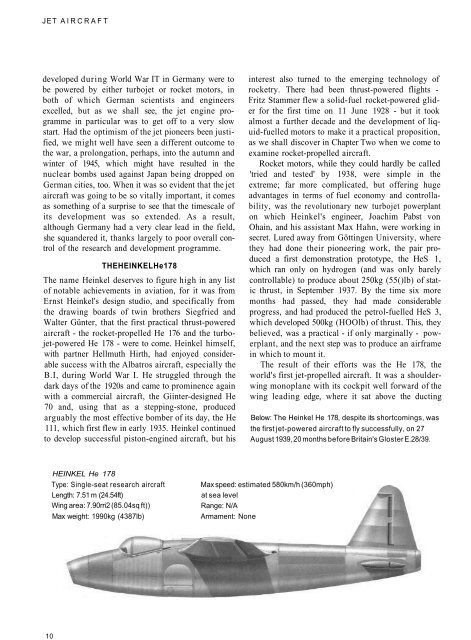Submarines and their Weapons - Aircraft of World War II
Submarines and their Weapons - Aircraft of World War II
Submarines and their Weapons - Aircraft of World War II
You also want an ePaper? Increase the reach of your titles
YUMPU automatically turns print PDFs into web optimized ePapers that Google loves.
JET AIRCRAFT<br />
developed during <strong>World</strong> <strong>War</strong> IT in Germany were to<br />
be powered by either turbojet or rocket motors, in<br />
both <strong>of</strong> which German scientists <strong>and</strong> engineers<br />
excelled, but as we shall see, the jet engine programme<br />
in particular was to get <strong>of</strong>f to a very slow<br />
start. Had the optimism <strong>of</strong> the jet pioneers been justified,<br />
we might well have seen a different outcome to<br />
the war, a prolongation, perhaps, into the autumn <strong>and</strong><br />
winter <strong>of</strong> 1945, which might have resulted in the<br />
nuclear bombs used against Japan being dropped on<br />
German cities, too. When it was so evident that the jet<br />
aircraft was going to be so vitally important, it comes<br />
as something <strong>of</strong> a surprise to see that the timescale <strong>of</strong><br />
its development was so extended. As a result,<br />
although Germany had a very clear lead in the field,<br />
she squ<strong>and</strong>ered it, thanks largely to poor overall control<br />
<strong>of</strong> the research <strong>and</strong> development programme.<br />
THEHEINKELHe178<br />
The name Heinkel deserves to figure high in any list<br />
<strong>of</strong> notable achievements in aviation, for it was from<br />
Ernst Heinkel's design studio, <strong>and</strong> specifically from<br />
the drawing boards <strong>of</strong> twin brothers Siegfried <strong>and</strong><br />
Walter Günter, that the first practical thrust-powered<br />
aircraft - the rocket-propelled He 176 <strong>and</strong> the turbojet-powered<br />
He 178 - were to come. Heinkel himself,<br />
with partner Hellmuth Hirth, had enjoyed considerable<br />
success with the Albatros aircraft, especially the<br />
B.I, during <strong>World</strong> <strong>War</strong> I. He struggled through the<br />
dark days <strong>of</strong> the 1920s <strong>and</strong> came to prominence again<br />
with a commercial aircraft, the Giinter-designed He<br />
70 <strong>and</strong>, using that as a stepping-stone, produced<br />
arguably the most effective bomber <strong>of</strong> its day, the He<br />
111, which first flew in early 1935. Heinkel continued<br />
to develop successful piston-engined aircraft, but his<br />
10<br />
HEINKEL He 178<br />
Type: Single-seat research aircraft<br />
Length: 7.51 m (24.54ft)<br />
Wing area: 7.90rri2 (85.04sq ft))<br />
Max weight: 1990kg (4387lb)<br />
interest also turned to the emerging technology <strong>of</strong><br />
rocketry. There had been thrust-powered flights -<br />
Fritz Stammer flew a solid-fuel rocket-powered glider<br />
for the first time on 11 June 1928 - but it took<br />
almost a further decade <strong>and</strong> the development <strong>of</strong> liquid-fuelled<br />
motors to make it a practical proposition,<br />
as we shall discover in Chapter Two when we come to<br />
examine rocket-propelled aircraft.<br />
Rocket motors, while they could hardly be called<br />
'tried <strong>and</strong> tested' by 1938, were simple in the<br />
extreme; far more complicated, but <strong>of</strong>fering huge<br />
advantages in terms <strong>of</strong> fuel economy <strong>and</strong> controllability,<br />
was the revolutionary new turbojet powerplant<br />
on which Heinkel's engineer, Joachim Pabst von<br />
Ohain, <strong>and</strong> his assistant Max Hahn, were working in<br />
secret. Lured away from Göttingen University, where<br />
they had done <strong>their</strong> pioneering work, the pair produced<br />
a first demonstration prototype, the HeS 1,<br />
which ran only on hydrogen (<strong>and</strong> was only barely<br />
controllable) to produce about 250kg (55()lb) <strong>of</strong> static<br />
thrust, in September 1937. By the time six more<br />
months had passed, they had made considerable<br />
progress, <strong>and</strong> had produced the petrol-fuelled HeS 3,<br />
which developed 500kg (HOOlb) <strong>of</strong> thrust. This, they<br />
believed, was a practical - if only marginally - powerplant,<br />
<strong>and</strong> the next step was to produce an airframe<br />
in which to mount it.<br />
The result <strong>of</strong> <strong>their</strong> efforts was the He 178, the<br />
world's first jet-propelled aircraft. It was a shoulderwing<br />
monoplane with its cockpit well forward <strong>of</strong> the<br />
wing leading edge, where it sat above the ducting<br />
Below: The Heinkel He 178, despite its shortcomings, was<br />
the first jet-powered aircraft to fly successfully, on 27<br />
August 1939, 20 months before Britain's Gloster E.28/39.<br />
Max speed: estimated 580km/h (360mph)<br />
at sea level<br />
Range: N/A<br />
Armament: None


